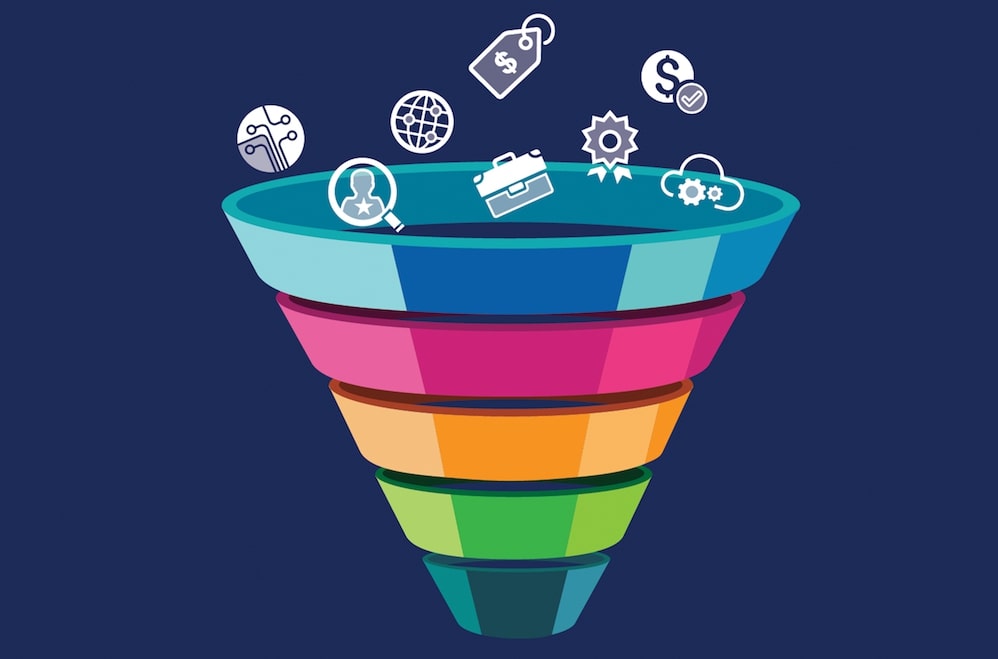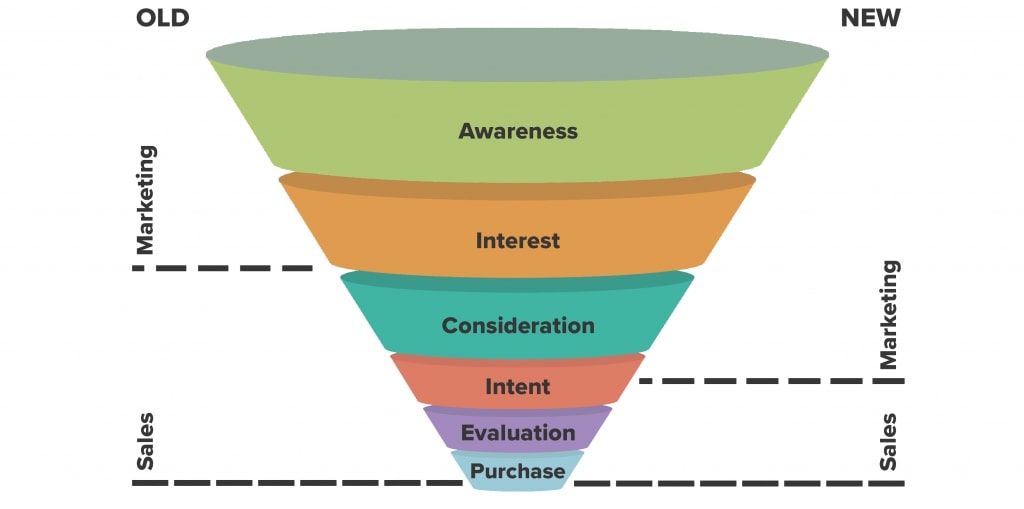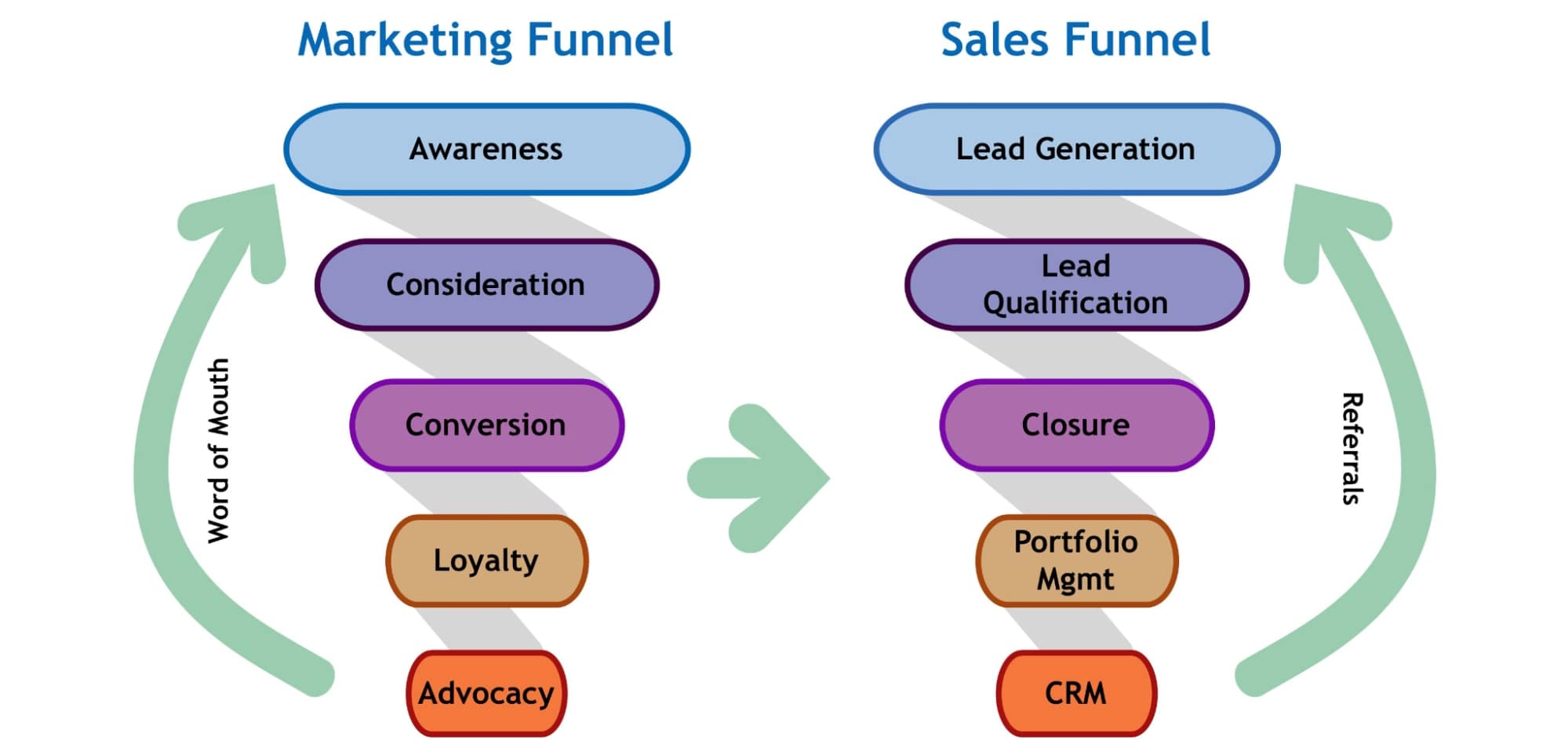Marketing funnel vs Sales funnel: What are the differences?
Marketing and sales are two tightly connected features that sometimes cause unjustified misunderstandings. Trying to separate one feature from the other is a difficult undertaking because both functions are linked closely. In addition, marketing is a broad operation including several business activities and is often linked to sales as a primary activity.
That being said, sales and marketing share a funnel. It’s a good thing. The difference between a sales funnel and a marketing funnel is therefore considerably more difficult to understand. Many entrepreneurs started adopting specific funnels to improve their revenue, although they don’t always know when to take the funnel.
This article analyzes one of the most debated topics, sales funnel and marketing funnel, to help you comprehend the terms, know how they are, and decide which is most matched to your brand.
What are different types of funnels?

A funnel may be expressed as a path from a single perspective to a genuine buyer, i.e. it is a group of acts before a customer acquires the preferred product or service. Many businessmen do not know that there is more than one sort of funnel or just put it in one huge bag and don’t distinguish it. And every funnel has its functions under different operations. It makes a difference when it comes to your desired goals and the direction of your online company. Some common types of funnels besides marketing funnels and sales funnels are:
- Lead magnet funnels
- Webinar funnels
- Email marketing funnels
- Event funnels
All of these follow the exact same thing despite the varying names: the conversion processes a prospective buyer takes, also known as the conversion funnels. Conversion funnels are modern buying funnels used by e-commerce companies. They work almost like funnel sales and marketing, which we shall be able to do in a moment.
Conversion funnels are also known as lean funnels that make them particularly focused on customization and client purchase based on customer comments. It makes them a bit more complicated than marketing and sales. But all of them are about the customers’ experience and this is an integrated part of each funnel.
What is a Marketing funnel?
A marketing funnel is a tool marketers use to analyze their audience’s engagement. The funnel uses messages, intents, and consumer cognition to match its creative assets. A marketing funnel is a journey through the study, learning, information, and decision-making processes of your audience.
Think about the shape of a funnel. Since the top is the broadest point and the lower point, all stages can be matched to marketing channels and messages. It matches your buyer’s journey, the level of intentions, and everything from introducing to converting your brand.

A funnel for marketing encourages people to become aware of a brand. It is also renowned for helping companies to visualize their client journey and develop certain marketing support tactics.
The marketing funnel consisted of three components: raising brand awareness, retaining interest, and client evaluation. The marketing funnel can be divided into three phases: lead generation, lead nurturing and lead conversion.
Phase 1: Lead generation
This phase represents the top of the marketing funnel and comprises two stages of building awareness and maintaining interest. During these stages, your clients are brand new and must be informed about your offerings. They don’t yet understand the situation, thus it’s your responsibility to make them aware.
- Goal: Be supportive and demonstrate your product’s competitive edge relevant to the market, education, and relationships
- Preferred channels: Content marketing, SEO, PR, Events, Trade Shows, Social media engagement interactions, etc.
- Content: Value-driven articles, blog posts, podcasts, viral videos, etc.
Many people make a mistake by assuming that prospects are available to buy at this time. You should not sell your products on them at this time, but rather make them aware of an issue that they confront. You can therefore present your product as a solution down the track.
Furthermore, strive to catch the right number of customers instead of attempting to capture as many customers as possible. At this stage, you must offer your audience value so that they desire to discover more about your brand.
Phase 2: Lead nurturing
The next phase is to foster lead as soon as the prospects of the brand increase. This phase lies in the middle of the funnel and represents the consideration stage. This is when a company tries to establish a successful relationship with the target by introducing them to the product or service with customized content to help them decide.
- Goal: Show your prospects your social proof to explain why they need to choose from you over others and illustrate why your offerings are the best on the market with technical information
- Preferred Channels: Frequent newsletters e-mails, social media engagement interactions, Google display network, Facebook/LinkedIn sponsored posts, etc.
- Content: reports, webinars, case studies, E-books, guidance, etc.
Users will know either your brand or the subject throughout the consideration process. They want to learn more about the problem so that they can decide the best way to go forward. But they are not 100% willing to commit themselves to a solution. These consumers visited your website and knew your brand, but did not buy any of your products.
This group looks for ways to address their problems but they are unwilling to buy. Since many various solutions are being considered, your brand needs to demonstrate to consumers why you are superior. Try to focus on your content, too. Not only will your prospect receive useful advice, but they don’t have to give up much to acquire it without thinking.
Phase 3: Lead conversion
This phase lies at the bottom of the marketing funnel in which your prospects finally have intents for purchases. At this point, the marketing funnel is slowly turning into a sales funnel. The leads are truly prepared to buy during this step in the journey of the customer. They will be willing to choose the ideal solution for you. This audience researched and understood each product’s various benefits.
- Goal: Get your users to join, buy your product and use your services
- Preferred Channels: Paid search, CTA, Facebook lead gen form, etc.
- Content: demo, free trial, customer testimonials, social proofs, FAQs, etc.
During the conversion process, users should know who you are, what your business is, and what information they will acquire. While individuals have already researched many other solutions at the decision stage, it will only further persuade them that the appropriate choice is your brand by giving them additional reasons to purchase. Make sure it is evident that you have a trial, a demo, or anything else in your team.
How to get a qualified lead in the marketing funnel?
Use specific outputs to qualify the lead with responses that the filter brings to different levels in order to get a qualified lead - whether by giving details about the size of the firm, the expected service, etc.
Also, keep an eye on the keywords where the lead has been driven to. This can help sales determine where they can start and how much information they would need. Various qualifiers can indicate what the marketing qualified lead is originally seeking, whether it is a comparison table, price information, other competitions, etc.
Additionally, businesses utilize CTA on landing pages as they let users tailor the approach by using multi-option formatting which path the user can decide what kind of information, activity, or response they want.
What is a sales funnel?
The aim of the marketing funnel is to attract potential customers that can soon become actual purchasers. When such potentials are discovered and a specific interest in the product or service of the brand develops, they join the sales funnel. The prospect would become a sales prospect from now on.
The sales funnel can take the lead and conversions from moderately interested to qualified and add revenue to its distinct identity. The sales funnel is extremely worthwhile for a business, as it helps to estimate revenue numbers, ROAS, and helps digital marketers identify which channels, keywords, designers, and consumers or various inputs have more profitability.

Each business has its own way to identify its sales funnel, and sometimes, the stages in the sales funnel may coincide with those in the marketing funnel if not separated distinctively based on their essence and functions. A clear business goal, an eCommerce marketing plan, and finally a focus of your target audience must be defined to help your business expand before you can begin creating your sales funnel. You need to take certain actions to build a business and stay successful.
In general, there are four main stages to consider for a sales funnel.
Phase 1: In-depth brand awareness
After the marketing lead is accepted, they will enter the sales funnel. This is where the first stage of the sales funnel begins. We can skip through the lead generation phase because the basic goal of our digital channels is to reach the user, drive leads, and optimize lead quality. This marketing qualified lead is used in the majority of organizations and it contains any conversion or leadership through marketing and achieves a minimal level.
A user must show interest as a marketing qualified lead by subscribing to a newsletter, completing in a form, downloading materials, etc. The main metrics are to impress customers with the size of the company, content engaged with the marketing funnel, keyword-driven articles, etc.
Phase 2: Interest
This step begins when the sales are consciously accepted by the prospects. This stage of the funnel is the first step mandated by the sales team. When a lead reaches the marketing qualified lead stage, a sales representative is automatically assigned. The sales team will evaluate this lead and consider it ready for more sales. Leads seldom stay at this stage for a long time because users know if they want to finish the process or not. Therefore, your sales team should try your best to keep your message consistent throughout the pitch, and always keep your prospects hooked with real backstory.
Phase 3: Decision
When the sales-accepted leads are considered ready for funneling, they will be advanced into the sales qualifying lead step. In this phase, the sales representative reached the sales-accepted leads and contacted them for a conversation, and got an understanding of what the consumer wanted (deal size).
Getting prospects to make a decision isn’t easy, and at this stage, reviews and testimonials are not powerful enough to convince. This time, you have to present your leads with real opportunities by offering attractive deals, benefits, bonuses and let them experience the fear of missing out (FOMO) if you hesitate. Also, you must guarantee your prospects a certain level of authority to gain their trust.
Phase 4: Action-Closing deal
This is when the lead is turned into an item for revenues. It is concluded, the level of expenditure is updated and the prospect is a customer. Stay updated on the percentages for future optimization, pipeline acceleration, and important improvement measures between each stage.
The sales funnel helps your company to transform. You can budget the full quarter and maximize the returns on ad spending by developing a pipeline of leads & prospects. Then you can see how filled is your prospect pipeline in times of uncertainty and assess how visitors go through the funnel.
Marketing Funnel and Sales Funnel-The differences

There is a line between the marketing funnel and the sales funnel. These terms are actually used interchangeably, and it is difficult to divide them off. The only major distinction between these phrases seems to be the context of applications.
Sales and marketing are typically two separate functions. Each has its own unique journey plan, which depicts a future customer’s growth. Marketing attracts attention and its funnel bottom represents the top of the sales funnel. The sales funnel is thus driven by marketing operations that raise awareness of the demand for products.
| Marketing funnel | Sales funnel |
|---|---|
| A marketing funnel is an elevated approach to take customers from being completely unaware of a specific brand to a loyal consumer. | The sales funnel is the way to encourage people to take action - subscribe to e-mail lists, participate in events, get real consultants, etc. |
| Consequently, the phases of the marketing funnel begin to expose the audience and end with conversion | It’s a number of sites designed to convince a buyer to go from being interested in your product to buying your product. In fact, a sales funnel is a marketing funnel in this way. |
However, this separation of departments is changing and integrating technologies used for sales and marketing. Therefore, there are blurred lines between sales and marketing, which is pushed by the need to characterize consumers as their sales and marketing approaches are accustomed.
Communication technology used in marketing vs sales funnels
A sales funnel or a marketing funnel is developed in order to turn potential buyers into paying clients. It is easier said than done because of the complexity of competitive markets to achieve this goal. But it’s no big deal to arrange a solid funnel with the correct technology tools including the integration of a business phone number for streamlined communication and customer engagement.
There are a variety of funnel sales and marketing tools if you’re a beginner. This software provides comprehensive, easy-to-use solutions to generate great outcomes. Sales funnel software alone cannot handle complex tactics for medium-sized and large enterprises. You need robust communication technologies to synchronize everything and create a collaborative atmosphere that supports sales and marketing initiatives.
For example, a cloud-based call center solution allows a company to manage client contacts across several platforms and thereby streamline the process of lead generation. It combines email, telephone, and web chat channels to let a potential customer communicate with a company easily. Other tools include email marketing tools, CRM tools, Lead generation tools, Advertising tools, etc.
Combining marketing vs sales funnel to optimize revenue
If you view messages, creative asset kinds, and CTA items as marketing funnels, it is a great plan to drop users as near to conversion. The job of marketing & media is to make every effort to qualify for leads so that sales are as informed as possible while entering the sales funnel. By bringing together your marketing approach and sales funnels, you can optimize your revenue by using the keyword.
You can identify your leading keywords, ad copy, site links, campaigns with media teams, or agencies by the amount of money it drives. Once you start to optimize your performance to greater sizes and create a big number of quality leads, it will start to speed up. You will also be able to build on multiple keywords to get the highest quality using your lead qualification procedure.
Final Words
Overall, the marketing and sales funnel are somewhere between the evaluation and engagement phases. However, this problem is often a subject of conflict among specialists in digital marketing. That is because the notion has developed and the border before the review phase has been higher.
Today, however, there are so many possibilities that are immediately born. Therefore we can only talk about buying prospects once the visitors have assessed them all and are ready for engagement. Only those committed visitors will become clients in today’s rapidly moving and continuously changing world. And it’s certainly not the last step to attract their attention.
New Posts






